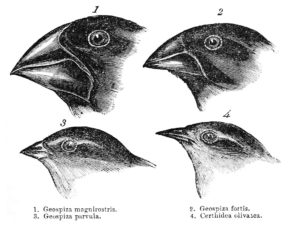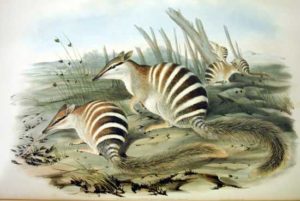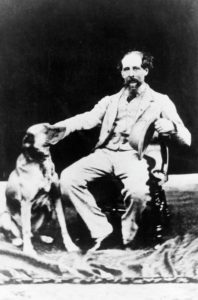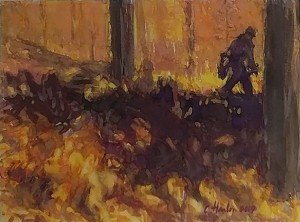Dear Artist,
English Economist Tim Harford defines creative growth as taking ideas from their original context and applying them elsewhere. Like cross training, he says, it inoculates our creative muscles against hitting a plateau. To avoid getting stuck, just change the subject. Here are a few ideas:

Darwin’s Finches: Large ground finch, Medium ground finch, Small tree finch, Green warbler-finch
by John Gould (1804-1881)
Organize your studio and surrounding areas like a Montessori classroom — with stations geared towards different projects you can flutter to and from. When work slows or you hit an obstacle, move to another station and pick up where you left off.
Harford suggests spreading interests a little wider than reasonable in order to spark insight and advance thinking. Hopping from field to field allows us to apply breakthroughs, boldness, risk and skill across disciplines.
Multi-tasking is an effective antidote to procrastination. If procrastination is, in part, a fear of failure, then jumping to an equally exciting project or one that you perceive to be less risky or more long-term can keep the wheels greased with skill building and muscle work.
Adopt a belief that no activities are bad ones — and that everything you’re doing is contributing to your creative work — including sleeping and exercise. Walking — Charles Darwin’s daily mania — satisfied his curiosity, aerated his brain, allowed him to reorganize ideas and settle himself with a moving meditation.
Do your multi-tasking in slow motion. Switching between projects quickly can make it impossible to progress meaningfully. Slow to longer, sustained periods at each station, fluttering lazily like a Quaalude-addled butterfly. After more than 30 years of experiments, observation and writing, Charles Darwin completed his masterwork On The Origin of Species in 1859. He was 50. All that time, he’d also been working on other ideas — books on earthworms, psychology, rocks and barnacles, his epic five-year journey on the HMS Beagle, marrying and having ten kids that included studying the development of his infant son, William, all the while obsessing over his orchids, reading Jane Austen, beetle-gazing and perfecting a devotion to what he called, “a very little walk in an idle frame of mind” with his fox terrier, Polly. On his “thinking path” — a sandy, oak-edged trail on the grounds of his property in Downe — Darwin ruminated on what would become his decades-in-the-making projects, with all the time in the world.
Sincerely,
Sara
PS: “Solving problems while in the bath — I can’t think of a better example of multi-tasking.” (Tim Harford)
Esoterica: The rhythms of truly inspired work require patience and curiosity. Harford cites choreographer and author Twyla Tharp as one of the great slow-motion multi-taskers. Tharp, a creature of highly tuned work habits, applies a system to her system in order to not get overwhelmed with ideas. “You have to be all things,” she says. She designates a cardboard box to each potential project and, over time, places nuggets of inspiration in each. “The box means I never have to worry about forgetting. I know where to find it, it’s all in the box.”
Have you considered a Premium Artist Listing? With each letter, an artist is featured at the bottom of this page. The Premium Artist Listings are a means of connecting artist subscribers through their work. Proceeds from each listing contribute to the production of The Painter’s Keys.
“It is not the strongest of the species that survives, nor the most intelligent that survives. It is the one that is the most adaptable to change.” (Charles Darwin)
Featured Workshop
Learn from the Master! The way to do accurate drawing with painterly approach. Join us for this 7 day retreat with 4 day workshop in magical settings of Mexican back country with one of the best instructors of drawing the human figure. From short pose gesture and anatomy studies, to long pose painterly approaches, students will learn step by step the drawing methods, human proportions, anatomy and much more. Live model with small class size will insure lots of personal attention.
Henry Yan has been teaching at Academy of Art University in San Francisco for more than twenty years. His book, “Henry Yan’s Figure Drawing – Techniques and Tips” published in 2006, has been widely used by art students and professional artists in the US and internationally.
Casa Buena Art Retreat is a calm and beautiful place to relax and explore your creative energy. Non painting partners welcome.
For more info check http://www.casabuenaartretreat.com/Retreat_HenryYan.htm
or contact Jane at janerom@shaw.ca
Featured Artist
Christine Hanlon, whose work has been compared to that of Edward Hopper, creates ‘urban landscapes which quietly exude atmosphere.’









18 Comments
I work through creative ideas and gain inspiration every day on my bike ride! It IS like meditation for me with the added bonus of burning hundreds of calories and keeping healthy! I always arrive home feeling refreshed and inspired to paint!
This advice is for the young. Older people start one task, get interrupted, forget what they were doing, and start another. The phone rings. Dad can’t find his socks. The doorbell rings. At the end of the day we are exhausted and
nothing has been completed!
Rubbish! I’m 71 and nothing that *you* said applies to me. At the end of my day I am not exhausted and plenty has been accomplished!
Ditto!
All that being said, I truly appreciated this article as I’ve often done some of these suggestions but betrayed myself and was criticized by others for doing so- yet it makes sense to me and I’ve found it is a pathway in problem solving. Very validating and the first article I’m printing out to see it prominently when I need to- thank you
I agree with you, Jean. Maybe because we are artists but also givers and others rely on us, sometimes excessively. Many artists are takers and I don’t believe they would experience these hurdles at all.
You’re not alone
The concept is nice, but my studio area simply is not large enough for multiple work stations, and it has to share the room with the model railroad. So partially-done, or works-in-progress are propped up here and there as reminders of what yet might be. They also get rotated, so the same canvas is not always visible or in the same place so long that it goes unnoticed. My wife has little patience with this approach – why start something else when you have these others to finish? She does have a point. Some do go on to completion, while others never seem to elicit the needed inspiration to invest more time and effort. That is where the magic eraser comes into play – the clean slate created by a fresh coat of gesso. The first few times are the most difficult, but not having the reminders looking at you constantly is also very liberating. We learn from each canvas, but sometimes the lesson is learned fairly quickly and there is little to gain by trying to make that proverbial silk purse from a cow’s ear.
There is another side to the walks. I see few “pretty skies” any more. Now it is more expressive and descriptive – look at the beautiful magenta tint to the clouds over there, or I love the green staining of the lichens and moss on that textured stump. We learn to see and appreciate when away from the studio, not when we are working in the confines of the studio and staring at limitations of the palette and canvas.
I find I get extremely scattered and accomplish nothing unless I focus on a single type of work, so I’ll do nothing but watercolors one month, then acrylic on wood next 2 months, and so on. However, within each discipline I usually work on one to six paintings at a time, shifting whenever I get stuck.
—
This is a great affirmation of how I function naturally . Some in my family see this way of being as confusing. And my walks have become an integral part of the creative life!
I just love this one Sara!!! My small studio is crammed with all sorts of incredible things and I often jump from one project to another until one completes itself. The only obstacle is storing the completed ones in limited space! I need to find a gallery that loves my odd assemblage work as much as I do!….problem solved! Daily walks, weather permitting, and occasional long hot baths help clear the brain and sooth the soul….good advice….Oh, and I’ll add the practice of gratitude….whining is for puppies.
LOVE this!!!
Multitasking. It comes so naturally to mothers. This article confirms my method of scattered interests as being viable and even preferable. Love it. Just finished a mammoth project and I am feeling somewhat drained yet excited about a more relaxed pace and some very different creativity. After I get some sleep.
Sara, Your writing here is beautifully demonstrative of its theme — integrating the scientific works of psychologists, naturalists, biologists/physical and mental training, etc., for application to the emotional world of artistic creatives. Wise advice, with inspiring examples! Thank you.
You described my studio only it’s a little more chaotic as we downsized recently so I share my space with a guest bed, family storage and files. Keep writing and inspiring us. Also I get plenty of walks to meet my dogs needs.
Having been a student of Human Anatomy and read the Origin of Species this writing by Darwin is so poetically written you wonder at the beauty of the writing even more so than the scientific reality it is trying to convey – even Darwin himself was not totally convinced of the truth of the evolution of one species to another but was almost forced into getting what he had discovered down on paper as it was such a revolutionary thought. Apart from this as a mother and now a grandmother I find the continual interruptions to the day are distracting from working on any large projects particularly when you have a very busy husband and you are the primary person to do chores, take care of the family and attend to the growth of your children but no complaints – I love my family and my art still gets quite a bit of attention even more so now they are all growing up and they have also become very creative because I have taken the time to allow them to be part of my creative world.
This is all so very interesting. Tim Hartford says spreading interests wider than reasonable. It seems that is the way I was born. It’s my nature. My personal art space is chaotic, but it’s comforting when all other things are ordered and calm, not that it always is. I am 79 and feel fortunate my passions for each and all of them has been a magical gift. It’s comforting to to know my son shares my “gift”, but I do not know if it’s nature or the example I set.
Good ideas. I especially like the one about walking. That is the best activity for me to relax and observe my surroundings (I live in the country). Another source of inspiration for me is art magazines. I have trouble finding time to really read them, but always come away with new ideas as well as techniques to apply them. That and your wonderful letters keep me going.
Getting one station set up is a challenge. Items are always migrating to someplace else. How do you guys DO it?